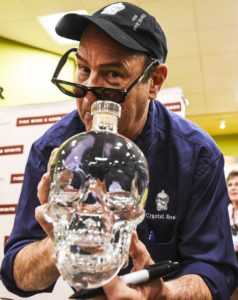

According to a study by Purdue University, mixing Red Bull with vodka, pictured above, can have effects on the brain that are equal to prolonged cocaine use.
By Ollie Gratzinger | Staff Columnist
We’ve all heard it: College is the time to let loose. In most contexts, that just means figuring yourself out and discovering what you want to dedicate your life to for the next forty-ish years.
No biggie, right?
Sometimes, though, experimenting can be taken to the next level, and some dabbles are more dangerous than others. Among the risks taken in the name of a good time is drinking unique and inventive combinations of alcohol, a depressant, and caffeine, a stimulant. If you’re one of those thrill seekers, you might want to think twice next time you reach for an energy drink as a mixer.
According to a study done at Purdue University, drinking alcohol — namely vodka — with things such as Red Bull will produce the same effect on the brain as taking cocaine.
Not only that, but the effects could be long-term. The experiment, which included giving both the alcohol/caffeine mixture and cocaine to different sets of adolescent mice, brought researchers to the conclusion that repeated exposure to the mixture during adolescence (which ranges from ages 10 to 19) could pose a threat to future behavioral and neurological development.
In other words, if you drink these things often, your brain will start to show signs of chronic cocaine use, the study says.
The long-term effects of these drink mixes remain largely unknown, but according to The Scientific American, a science magazine, one major concern is that the prefrontal cortex, which is the part of the brain utilized for decision making and impulse control, isn’t fully developed until around age 25. That’s probably why teens and young adults often make these borderline questionable choices in the name of a fun night, but it might be those choices that prevent the brain from reaching maturity in due time.
In addition to that, there’s a rising concern about blood-alcohol concentration and how mixing caffeine and alcohol can lead to lethal levels. Since you’re less likely to feel the effects of the drink when it’s mixed as such, it’s easy to consume too much. The legal limit of blood-alcohol concentration is .08, but The Scientific American recounts an instance in which nine Central Washington University students were hospitalized following a party in 2010 at which Red Bull and vodka was consumed, and their levels ranged from .123 to .35. The article further clarifies that anything nearing or exceeding .3 can be deadly.
It’s important to note that this isn’t the first time that we’ve seen the mass popularization of these somewhat-unhealthy drinks. Four Loko, a well-known alcohol/caffeine concoction, has been the debate of health concerns since its inception over a decade ago. The main issue wasn’t so much that the drink produced a drug-like high, but rather that the caffeine interfered with the sensory cues one might rely on to determine their levels of intoxication. Thus, the drinker would find themselves drunker, faster.
According to the Purdue University study, the same thing applies to the infamous Red Bull and vodka mixed drink that’s quickly becoming a favorite among teens and young, often underage, adults.
Duquesne students are skeptical, though. Asking around, it became apparent that those who have mixed the two reported nothing more than a slightly stronger buzz, if even that. In most cases, the students, who wish to remain anonymous, place the study and its findings on the level between paranoid conspiracy theories and idealistic cures for boredom.
At this age, however, it isn’t uncommon to feel invulnerable and invincible to the dangers of the world. Life is just beginning to open up and unfold into a curious rush of newness and independence. There’s a level of desperation to experience all that there is to feel and to experience it at a level that transcends depth. For most college freshmen, moving into dorms marks the first step in moving away from our parents. The traditional my-roof-my-rules condition no longer applies, and we as young adults are free to set our own regulations, test our limits and explore what it means to be human. For that reason, this a phase of our lives that is dual parts unique and dangerous.
We aren’t wired to think in terms of future consequence right now, finding instead that it’s easier — and often more fun — to live for the here and now.
There’s still the question lingering of whether or not these drinks produce the same effects on the brain as prolonged cocaine exposure. The Purdue University study set a strong foreground for future exploration into the topic, but as of now, the true effects still remain somewhat enigmatic. There’s no question that the drinks do, however, have the potential to cause great harm and health risks, so next time you find yourself on the South Side searching for a good time, consider reaching for something else to drink.




